A mystery in the world’s oldest desert
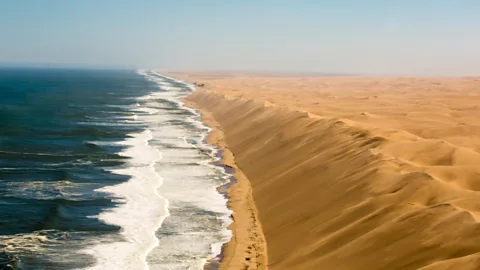 Kate Schoenbach
Kate SchoenbachSome believe they’re footprints from the gods, others think they’re formed by dancing fairies or UFOs, but no-one can explain these millions of mysterious circles in the desert.
 Kate Schoenbach
Kate SchoenbachAs people around the world are sheltering in place, many are eagerly awaiting the day they can travel again. To help people cope and to remind them of how beautiful the world can be, BBC Travel is updating some of our most popular stories on natural phenomena and man-made marvels.
Located along south-western Africa’s Atlantic coast, the Namib Desert is one of the driest places on Earth. Meaning "an area where there is nothing" in the local Nama language, this Martian-like landscape of towering sand dunes, rugged mountains and gravel plains stretches some 81,000 sq km across three countries.
Dating back at least 55 million years, the Namib is believed to be the world’s oldest desert (the Sahara is thought to be just two to seven million years old). With summer temperatures routinely reaching 45C and nights that can dip below freezing, it’s also one of the most inhospitable places on the planet. Yet, over time, a staggering number of species have adapted to call this arid wonder home – and in the process, created a bizarre geomorphic phenomenon that continues to baffle experts.
 Kate Schoenbach
Kate SchoenbachThe Namib Desert extends more than 2,000km from southern Angola through Namibia and into northern South Africa. From where it tumbles dramatically into the ocean, this seemingly endless sea of silica stretches eastward from Namibia’s Atlantic coastline, reaching up to 160km inland to the edge of southern Africa’s Great Escarpment.
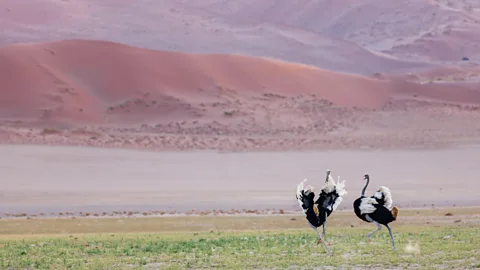 Kate Schoenbach
Kate SchoenbachThe most arid parts of the Namib receive an average of just 2mm of rainfall a year. During some years, parts of the desert receive none. But as if appearing out of a mirage, animals like oryx, springbok, cheetahs, hyenas, ostriches and zebras that have adapted to survive in these harsh conditions scamper across the desert.
Ostriches raise their body temperatures to reduce their water loss; Hartmann’s mountain zebras are deft climbers that have adapted to the desert’s rugged terrain; and oryx can survive for weeks without drinking by eating water-rich foods like roots and tubers.
 Kate Schoenbach
Kate SchoenbachOne of the most treacherous areas of the inhospitable Namib is a 500km expanse of soaring sand dunes and rusting ship hulls along the Atlantic known as the Skeleton Coast. Stretching from southern Angola to central Namibia, the area takes its name from the many whale carcasses scattered across its shores and the nearly 1,000 shipwrecks that have littered its coastline over the centuries.
The stark Skeleton Coast is often shrouded in dense fogs, created by the upwelling of the Atlantic Ocean’s cold Benguela current, which clashes with the hot air from the interior of the Namib Desert. These fogs create dangerous navigating conditions for ships, and the local San people have called the region "the land God made in anger".
While sailing along Africa’s western coast, famed Portuguese explorer Diogo Cão briefly stopped at the Skeleton Coast in 1486. After Cão and his men erected a cross inscribed with the Portuguese coat of arms, the Namib’s daunting sand dunes and harsh climate quickly led them to turn back to the sea – but not before famously calling the area "The Gates of Hell".
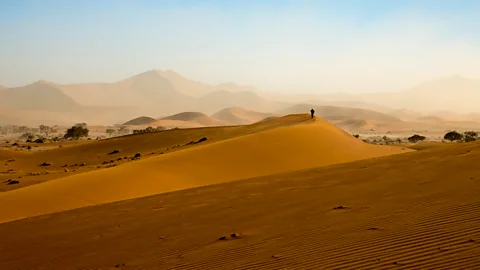 Kate Schoenbach
Kate SchoenbachToday, tourists come to the Namib to see the spectacular rolling ochre sand dunes surrounding Sossusvlei, a salt and clay pan in the centre of Namib-Naukluft National Park – Africa’s third-largest national park, at nearly 50,000 sq km.
While sand dunes are an omnipresent feature throughout the Namib, the surrounding Sossusvlei possesses a particularly deep orange hue. This colour is actually rust, and is an indication of the oxidation process resulting from a high concentration of iron in the sands. The dunes in this area are also some of the highest in the world. Many are more than 200m in height, while the so-called "Dune 7", situated north of the red Sossusvlei landscape, soars nearly 400m into the sky.
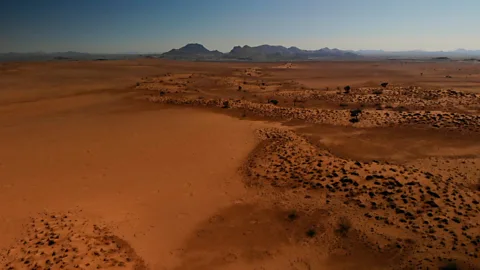 Kate Schoenbach
Kate SchoenbachOf the Namib’s many marvels, one of its most intriguing features and greatest mysteries is a geomorphic phenomenon known as "fairy circles". Sometimes called "fairy rings", these barren patches of sand encircled by a single species of grass are found throughout the Namib Desert and have baffled experts for decades.
 Kate Schoenbach
Kate SchoenbachThe rings are best viewed from the air, where one can marvel at the circles’ matrix spreading out endlessly across the desert sands. Found both in the Namib’s flat gravel plains and on the desert dunes, fairy rings maintain their near-perfectly circular shape in both terrains. The circles range from 1.5m to 6m in diameter in the central Namib, while in north-western Namibia, they’re roughly four times as large and can reach up to 25m wide.
For years, fairy rings were thought to exist only in Namibia, but in 2014, similar formations were discovered in Western Australia when environmental scientist Bronwyn Bell was surveying the remote Pilbara region. Perplexed by these spectacular formations, she contacted Stephan Getzin, a German-based ecologist and fairy-circle expert, to share her discovery. While the Australian circles closely resemble those found in Namibia, differences in their soil composition have further baffled scientists.
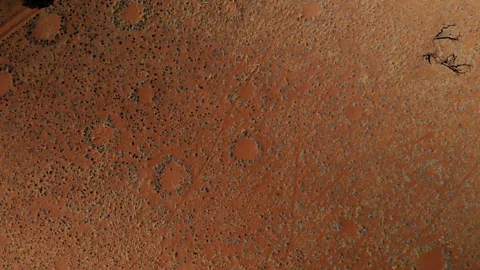 Kate Schoenbach
Kate SchoenbachWhile experts are mystified by the cause of these "fairy" formations, the circles have long been known to local Namibians. The local Himba people believe they are caused by spirits, and are footprints left by their god, Mukuru.
To understand their origin, mathematicians have even tried to create models to see if the rings fit a recognisable pattern. But Hein Schultz, the owner of the Rostock Ritz Desert Lodge located just outside the Namib-Naukluft National Park, explains that some locals believe these mysterious circles are caused by “UFOs or fairies dancing at night”.
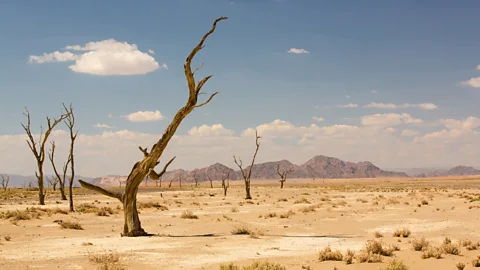 Kate Schoenbach
Kate SchoenbachTo date, there remains no universally accepted theory as to the source of these curious circles. But in recent years, scientists from Namibia, Germany, the United States and elsewhere have come together to study the phenomenon in hopes of better understanding it.
At the Gobabeb - Namib Research Institute, a remote research centre in the heart of the desert, entomologist Eugene Marais explained that the two major theories stem from the scarcity of water in the Namib. Some research suggests the circles are caused by termites, which create these circles in order to harvest water and nutrients from the ground. By clearing vegetation from the land, the termites create a barren space in the soil, which allows rainfall to seep deeper into the earth. The theory suggests that termites stay hydrated by drinking from these underground reservoirs year-round.
The other major theory is that of "vegetation self-organisation", where root competition between the grasses causes the circular bare patches to appear as a reservoir from which to extract nutrients and water from the surrounding area.
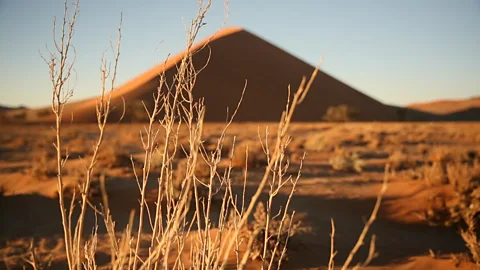 Kate Schoenbach
Kate SchoenbachAfter years of drought, fairy circle grass can eventually dry up and seemingly disappear. Marais highlights the wonder of this landscape by saying that, when it does rain, all of a sudden, “like magic”, the circles pop up again.
According to Marais, research on the Namib’s fairy rings has generally focused on circles in isolated stretches of the desert’s gravel plains or those found in the sand dunes. But to truly understand these formations, he believes that research must expand across both terrains.
In the end, Marais has a hunch that these strange splotches dotting the desert are caused by a combination of factors. But what, exactly, those factors are remains a mystery to this day.
World of Wonder is a BBC Travel series exploring some of the most awe-inspiring natural phenomena and manmade marvels around the globe.
